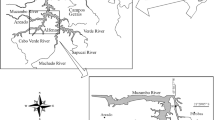Abstract
The life-cycle, growth, and reproductive success of a stream-dwelling Erpobdella octoculata (L.) were studied over a 19-month period at two sites, one above and one below an input of zinc pollution from mine-waste. Samples were collected monthly using quadrats. The blotted wet weight of all leeches was measured. An histological technique was employed to determine sexual maturity. Reproductive success was measured by estimating the numbers of cocoons and number of eggs per cocoon at each site. A wet ashing technique, followed by analysis using flame atomic absorption spectrometry, was used to determine the extent of bioaccumulation of zinc. ‘Total’ zinc and other metals in the waters were similarly analysed.
Differences were found between the populations at the two sites. The life-history of the Erpobdella above the contamination was comparable to that found for other stream-dwelling populations previously studied. Observed differences in densities of leeches between sites in the present and in previous studies by other workers may be due to recorded differences in the abundance of available food. At the polluted site, there was evidence that (a) there was a delay in cocoon deposition and hence hatching of young, (b) the adult leeches produced more misshapened and empty cocoons, (c) no relationship existed between the area of cocoons with eggs and number of eggs present, and (d) the proportion of young to adult leech was smaller at the polluted site. At the polluted site, higher levels of zinc were recorded in the tissues of Erpobdella and there was some evidence for the active intake of zinc by the leech.
Similar content being viewed by others
References
Aston, R. J. & D. J. A. Brown, 1975. Local and seasonal variations in populations of the leech Erpobdella octoculata L., in a polluted river warmed by condenser effluents. Hydrobiologia 47: 347–366.
Batley, G. E. & D. Gardener, 1977. Sampling and storage of natural waters for trace metal analysis. Wat. Res. 11: 745–756.
Bouvet, J., 1977. Notes fur les Hirudinees des Alpes Francaises. III. Erpobdella octoculata L. Trav. Lab. Hydrobiol. 66–68: 89–94.
Brooks, R. R. & M. D. Rumsby, 1965. The biogeochemistry of trace elements uptake by some New Zealand bivalves. Limnol. Oceanogr. 10: 521–27.
Brown, B. E., 1977. Effects of mined rainage on the River Hayle, Cornwall A) Factors affecting concentrations of copper, zinc and iron in water, sediments and dominant invertebrate fauna. Hydrobiologia 52: 221–223.
Elliott, J. M., 1971. Some methods for the statistical analysis of samples of benthic invertebrates. F.B.A. Sci. Publ. 25:
Elliott, J. M., 1973a. Life cycle and production of the leech Erpobdella octoculata in a Lake District stream. J. anim. Ecol. 42: 448–459.
Elliott, J. M., 1973b. Daily activity pattern, drifting and food of Erpobdella octoculata in a Lake District stream. J. anim. Ecol. 42: 448–459.
Eyres, J. P. & M. Pugh-Thomas, 1978. Heavy metal pollution of the R. Irwell (Lancashire, U. K.) demonstrated by analysis of materials and macro invertebrate tissue. Environ. Pollut. 16: 120–136.
Harding, J. P., 1948. The use of probability paper for the graphical analysis of polymodal frequency distribution. J. mar. biol. Ass. U.K. 28: 141–153.
Harding, J. P. C. & B. A. Whitton, 1981. Accumulation of zinc, cadmium and lead by field populations of Lemanea. Wat. Res. 15: 301–320.
Mann, K. H., 1953. The life history of Erpobdella octoculata (L.). J. anim. Ecol. 22: 199–207.
O'Grady, K. T., 1978. Some aspects of trace metals in brown trout (Salmo trulta L.). Unpublished Ph.D. Thesis, Liverpool Univ.
Say, P. J. & N. Giani, 1981. The Riou Mort, a tributory to the river Lot polluted by heavy metals, 2. Accumulation of zinc by Oligochaetes and Chironomids. Acta oecol., Oecol. Applic. 2: 339–355.
Willis, M., 1981. Heavy metals in a mountain stream ecosystem. Unpublished Ph.D. Thesis, Liverpool Univ.
Willis, M., 1983. A comparative survey of Ancylus, fluviatilis (Muller) populations in the Afon Crafnant, N. Wales, above and below an input of zinc from mine-waste. Arch. Hydrobiol. 98: 198–214.
Young, Y. O., 1981. A comparative study of the food niches of lake-dwelling triclads and leeches. 3rd Int. Symp. Turbellaria. Hydrobiologia 84: 91–102.
Young, J. O. & J. W. Ironmonger, 1979. The natural diet of Erpobdella octoculata (L.) (Hirudinea: Erpobdellidae) in British Lakes. Arch. Hydrobiol. 87: 483–503.
Young, J. O. & J. W. Ironmonger, 1980. A laboratory study of the food of three species of leeches occurring in British Lakes. Hydrobiologia 68: 209–215.
Young, J.O. & J. W. Ironmonger, 1982. A comparative study of the life histories of three species of leeches in two British Lakes of different trophic status. Arch. Hydrobiol. 94: 218–250.
Author information
Authors and Affiliations
Rights and permissions
About this article
Cite this article
Willis, M. A comparative survey of the Erpobdella octoculata (L.) populations in the Afon Crafnant, N. Wales, above and below an input of zinc from mine-waste. Hydrobiologia 120, 107–118 (1985). https://doi.org/10.1007/BF00032131
Received:
Accepted:
Issue Date:
DOI: https://doi.org/10.1007/BF00032131




